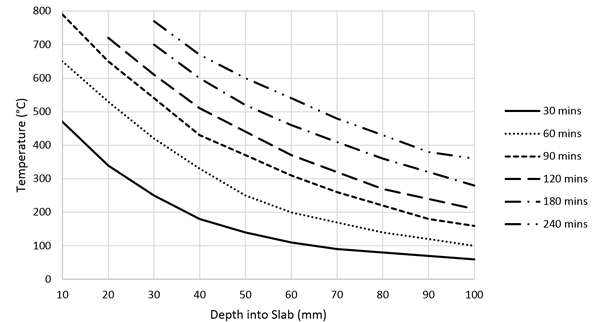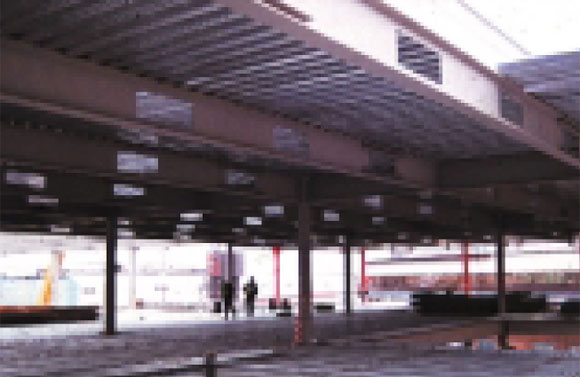Technical
Temperature profiles through composite slabs at elevated temperatures
Callum Heavens of the SCI discusses different methods for determining temperature profiles through composite slabs at elevated temperatures.
Introduction
The resistance of composite slabs at elevated temperatures is dependent on the temperatures that the critical regions of the slab reach within a given period of time. The strength of the steel in the deck, and in any bar or mesh reinforcement, reduces with temperature, as does the strength of the concrete within the slab. It is imperative that the temperatures of these components be determined accurately when designing the slab in order to satisfy the requirements of a given fire resistance period.
The temperature profile through the slab is dependent on the depth into the slab from an exposed surface but determining exact temperatures at a given depth is complicated by the shape (re-entrant or trapezoidal) and dimensions of the deck profile, as well as the moisture content of the concrete.
The components contributing to the sagging and hogging resistance of the slabs will depend on the particular design method being employed (such as the “Mesh & Deck” method or the “Bar” method). However, regardless of the chosen method, the temperature is obtained by a temperature profile which may be tabulated or given by equation.
BS 5950-8 and BS EN 1994-1-2 provide tabulated temperature data for light and normal weight concretes for different fire resistance periods, whilst NCCI document PN005c provides a set of calibrated equations which give temperature as a function of depth, considering the fire period and concrete type. By determining the temperature at the location of interest, the reduction in strength of the material can then be evaluated for British Standard design using BS 5950-8 Table 1 to Table 3 or for Eurocode design using BS EN 1994-1-2 Table 3.2 to Table 3.4.
BS 5950-8
Fire resistant design to British Standards is given in BS 5950-8:2003, with composite slabs being discussed in Section 8.9.
Here, the temperature profile through a 100mm composite floor slab with a profiled steel deck is given in Table 12. This table provides temperatures at 10mm intervals through the slab for both normal and lightweight concretes and for fire resistance periods in steps of 30 minutes from a minimum duration of 30 minutes up to a maximum duration of 240 minutes.
This data is plotted in Figure 1 for normal weight concrete. BS 5950-8 only provides temperature data up to a maximum temperature of 800°C. No distinction is made between the temperature profiles of re-entrant or trapezoidal slab decks. Instead, it is stated that the temperature relates to a location at the prescribed distance from the nearest exposed surface, whether that be the deck soffit, rib wall or top of a re-entrant dovetail.
No limits are placed on the scope of this tabulated data, however, the limits on the applicability of the insulation criteria should be noted.

Figure 1: Temperature profiles through a 100mm composite slab according to BS 5950-8 for normal weight concrete.
Figure 1: Temperature profiles through a 100mm composite slab according to BS 5950-8 for normal weight concrete.
BS EN 1994-1-2
The temperature model for composite slabs in the Eurocodes is given in BS EN 1994-2:2005 Annex D. This annex provides methods for separately considering the thermal insulation requirements, the sagging resistance and the hogging resistance.
As part of determining the hogging resistance, Table D.5 provides tabulated temperature data throughout a 100mm slab for fire durations of 30 to 240 minutes for normal weight concrete (it is stated that for lightweight concrete, the temperatures should be reduced to 90% of the normal weight values). As with BS 5950-8, only temperatures up to 800°C are presented in the table.
The use of this table differs slightly from BS 5950-8 in that the depth is measured from the base of an “effective slab height” which is equal to the cover depth of concrete above the deck in addition to some portion of the rib height (determined by the rib dimensions).
The scope of this data is limited by a set of dimensional requirements which are given in Table D.7 of Annex D.
Annex D is an informative Annex. Its use is determined by the National Annex which states that it “should not be used” with “alternative guidance given” by “reference to non-contradictory complementary information”.
NCCI PN005c
PN005c is non-contradictory complementary information that provides an alternative to the guidance presented in Annex D of BS EN 1994-1-2. Rather than provide tabulated data as in the case of BS 5950-8 and BS EN 1994-1-2, the NCCI provides three calibrated equations for determining the temperature profile through a composite slab for each of normal and lightweight concrete.
The equations are quadratic curves fitted to data obtained from a combination of physical test results and finite element (FE) results calibrated against these tests. The temperature profile within the width of the rib (i.e. over the full slab depth) is described by two curves. The first curve applies over the first 80mm above the deck soffit and the second applies to the remainder of the slab depth. Over the reduced depth of the slab, the profile is described by a third curve.
The coefficients of each of these quadratics are tabulated for fire resistance periods of 30, 60, 90 and 120 minutes, with some of these values dependent on parameters determined by the profile height, slab depth or trough width. These equations lead to temperature distributions through the slab of the general form illustrated in Figure 2. Different coefficients are presented depending on whether the deck is re-entrant or trapezoidal.

Figure 2: Illustration of a typical temperature distribution through a composite slab.
The slab can be divided into a number of thin horizontal strips whose temperatures can then be determined using the equations discussed previously. The temperature of any mesh reinforcement can be determined from the temperature of the concrete strip at the level of the mesh. Separate equations are given for determining the temperature of bar reinforcement.
In addition, by applying these equations to a number of locations along the top surface of the slab, the acceptability of the slab with regard to the insulation criteria (also specified in PN005c) can be determined by evaluating the maximum and average temperature rises along this surface. A typical surface temperature profile is shown in Figure 3.
The scope of PN005c is limited to a specified range of deck geometries, however, this range covers the majority of deck profiles available within the UK. For trapezoidal decks, the profile height is required to be in the range 60-80mm whilst the bottom flange width should be between 100-130mm. For re-entrant decks, the profile height should be in the range 50-60mm and the bottom flange width in the range 120-150mm.

Figure 3: Illustration of a typical temperature distribution along the surface of a composite slab
Profile Comparisons
Figures 4 and 5 show a comparison of the temperature profiles given in BS 5950-8, BS EN 1994-1-2 and PN005c for fire resistance periods of 90 minutes and 120 minutes respectively. The profiles are plotted for a typical 60mm trapezoidal deck with a bottom flange width of 125mm and a total slab depth of 140mm. The profiles are also plotted against physical test data obtained from tests on a slab of the same geometry and the results of an FE analysis. All data is for normal weight concrete.

Figure 4: Comparison of temperature profiles for a 90 minute fire (using normal weight concrete)

Figure 5: Comparison of temperature profiles for a 120 minute fire (using normal weight concrete)
It can be seen that BS 5950-8 and BS EN 1994-1-2 provide very similar profiles. However, at some depths into the slab, both profiles are un-conservative when compared to the physical test data. This is even more noticeable for the 120 minute fire resistance period where temperature differences can be as high as 100°C.
It would appear on first inspection that PN005c produces overly conservative results. However, it should be noted that these equations are required to take account of a range of deck and slab geometries. The PN005c curves provide an envelope on the actual temperature profile through the composite slab in all of these cases.
The FE results tend to provide relatively good agreement with the test data, being slightly conservative in most cases. Where the FE results are un-conservative, they indicate only very slightly lower temperatures than the test data. In cases where a deck or slab geometry falls outside of the scope of the codes or PN005c, FE analysis is an accurate alternative for determining an appropriate temperature distribution through a composite slab and is especially useful for profiles of unusual geometry.
Conclusions
1. BS 5950-8 and BS EN 1994-1-2 provide tabulated data for temperature profiles which in some cases can be un-conservative. The two codes produce very similar temperature profiles but the UK National Annex does not allow the use of the profiles provided in BS EN 1994-1-2.
2. PN005c provides a set of calibrated quadratic equations to describe the temperature profile in different locations within a composite slab. It takes account of a range of deck geometries to provide safe temperature profiles.
3. FE analysis is a suitable alternative to the curves presented here and is particularly suited to unusual deck profiles which may fall outside the scope of the codes and NCCI document.
A future article will consider how the temperature profile through the slab can be used in the design of composite beams in fire.
References
1 BS 5950-8:2003
Structural use of steelwork in building – Part 8: Code of practice for fire resistant design
BSI, 2003
2 BS EN 1994-1-2:2005
Eurocode 4 – Design of composite steel and concrete structures – Part 1-2: General rules – Structural fire design
BSI, 2005
3 PN005c-GB
NCCI: Fire resistance design of composite slabs
The Steel Construction Institute
4 NA to BS EN 1994-1-2:2005
UK National Annex to Eurocode 4: Design of composite steel and concrete structures – Part 1-2: General rules – Structural fire design
BSI, 2008












